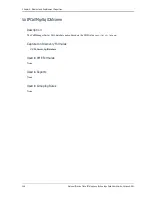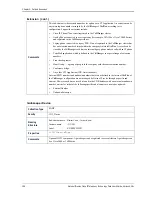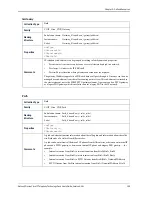
Chapter 5: Defined Resources
Netcool/Proviso Cisco IP Telephony Technology Pack User’s Guide, Version 4.3-W
159
Gateway
Collection Type
Bulk
Family
VOIP_Cisco_CDR_Gateway
Naming
Structure
Sub-element name: Gateway_
ElementName
_<
gatewayIpAddress
>
Instance name:
Gateway_
ElementName
_<
gatewayIpAddress
>
Label:
Gateway_
ElementName
_<
gatewayIpAddress
>
Properties
cdrType
CDRclusterId
CDRcustomerId
CDRsiteId
Comments
IP telephony sub-elements can be grouped according to family name and properties:
•
Per customer: A customer can have one or several clusters deployed in a network.
•
Per cluster: A cluster is the IP-PBX itself.
•
Per site: Physical location where gateways and extensions are deployed.
The gateway IP address appears in a CDR each time a call goes through it. Gateways can then be
managed as a sub-element from the call-accounting point of view. This sub-element is attached to
the cluster element, not to the SNMP PSTN gateway element. A gateway can be a PSTN gateway
or a legacy PBX gateway, which is useful to connect a legacy PBX to the IP network.
Path
Collection Type
Bulk
Family
VOIP_Cisco_CDR_Path
Naming
Structure
Sub-element name: Path_
ElementName
_<
caller_callee
>
Instance name:
Path_
ElementName
_<
caller_callee
>
Label:
Path_
ElementName
_<
caller_callee
>
Properties
cdrType
CDRclusterId
CDRcustomerId
Comments
A path sub-element contains information about the calling site and information about the callee
site. Both ends of a call are from different sites.
A path can be an internal call between 2 IP phones from different sites, or between an internal IP
phone and a PSTN gateway, or between an internal IP phone and a legacy PBX gateway — for
example:
•
Internal extension from SiteA to internal extension from SiteB (SiteA_SiteB)
•
Internal extension from SiteB to internal extension from SiteA (SiteB_SiteA)
•
Internal extension from SiteA to PSTN Gateway from SiteB (SiteA_GatewayIPAddress)
•
PSTN Gateway from SiteB to internal extension from SiteA (GatewayIPAddress_SiteA)
















































